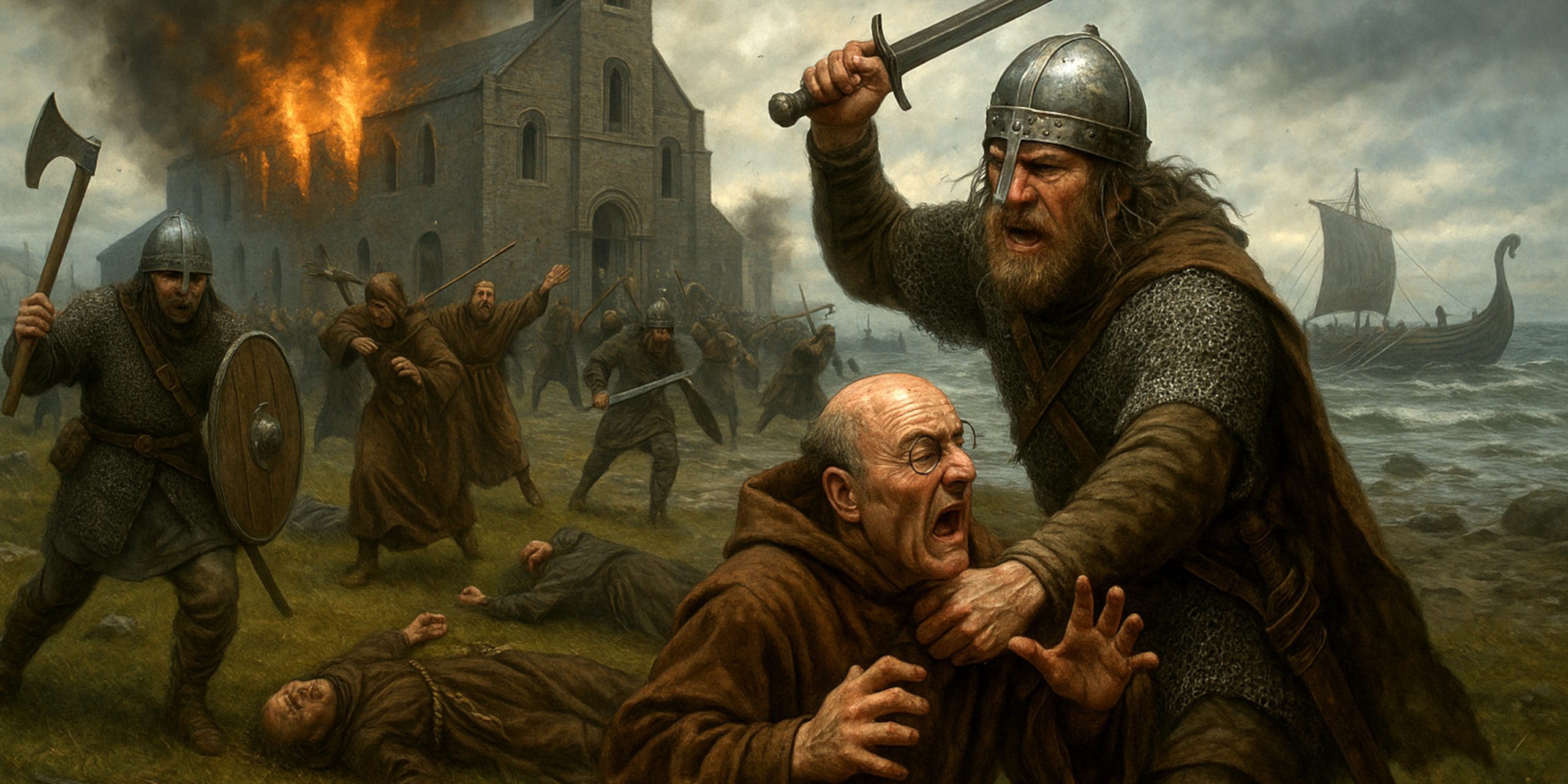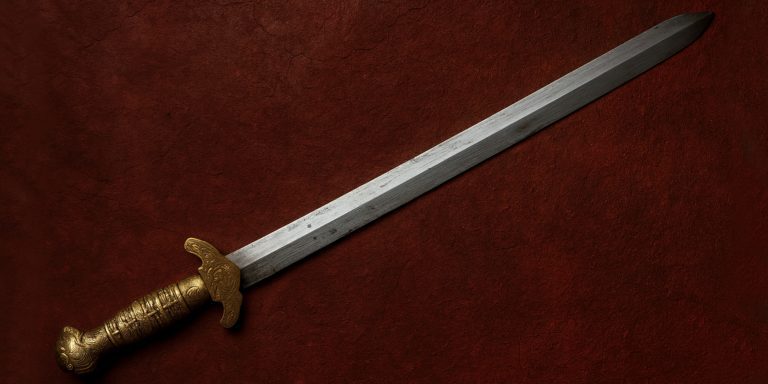
The raid on Lindisfarne in 793 AD is remembered as the moment Europe awoke to the Viking threat. Though Norse seafarers had likely visited Britain before, this brutal strike against a holy island sent tremors through Christendom. Monks were killed or enslaved, treasures looted, and sacred spaces desecrated. Chroniclers saw it not as mere piracy, but as divine punishment or the herald of apocalypse.
As a historian, what fascinates me most is not just the savagery, but the symbolism. Lindisfarne represented spiritual purity on the edge of the world. For the Vikings to attack it was an act of both shocking violence and dark genius.
Lindisfarne Before the Raid
Founded around 634 AD by Saint Aidan at the invitation of King Oswald of Northumbria, Lindisfarne became a cornerstone of early English Christianity. Its monks blended Celtic and Roman traditions, producing works of immense cultural value like the Lindisfarne Gospels, a manuscript of staggering artistry.
The monastery’s isolation on a tidal island made it perfect for contemplation, but also perilously exposed. With the tide low, it was accessible from the mainland. When the tide rose, it was cut off. This geography, once a symbol of devotion, would become its downfall.
The Raid of 793 AD
In early summer, ships appeared on the horizon. The Anglo-Saxon Chronicle gives the stark account:
“In this year, fierce foreboding omens came over the land of the Northumbrians… and the harrying of heathen men miserably destroyed God’s church on Lindisfarne.”
These were Scandinavian warriors, most likely from the Norwegian coast. They landed swiftly, slaughtered monks, seized gold, and dragged survivors into bondage. The altar was overturned, relics scattered, and the monastery burned.
Alcuin of York, writing from Charlemagne’s court, put the horror into words that still resonate:
“Never before has such terror appeared in Britain… The heathens poured out the blood of saints around the altar.”
It was more than a raid; it was an assault on the idea of Christendom itself.
Who the Vikings Were
The men who struck Lindisfarne were not kings or empire-builders. They were seafarers from small, coastal Scandinavian communities. Their longships, fast and light, allowed them to strike suddenly and vanish before word could spread.
At this stage, Viking society was still fragmented. Raiding offered young men wealth, honour, and prestige in a world where local resources were scarce. Lindisfarne, rich and undefended, was the perfect target.
This was not the first Norse contact with Britain, but it was the first that truly mattered, the one that would make every coastal settlement reconsider its defences.
Timeline of Key Events
| Date | Event | Significance |
|---|---|---|
| 634 AD | Foundation of Lindisfarne Monastery by Saint Aidan | Becomes the centre of Northumbrian Christianity |
| 685 AD | Death of Saint Cuthbert | His relics draw pilgrims and establish Lindisfarne’s sanctity |
| 793 AD (June) | Viking raid on Lindisfarne | Monks slain, treasures looted, monastery desecrated |
| 794 AD | Viking raid on Jarrow | Confirms that Lindisfarne was not an isolated event |
| 795–806 AD | Raids on Iona and other western monasteries | Spread of Viking activity across the British Isles |
| 865 AD | Arrival of the Great Heathen Army | Marks the shift from raiding to conquest |
| 875 AD | Monks of Lindisfarne flee with Cuthbert’s relics | Foundation of Durham Cathedral’s monastic line |
| 1100s | Construction of new priory on Lindisfarne | Revival of pilgrimage and continued monastic life |
| 1897 | Discovery of Viking artefacts near Holy Island | Confirms continued Scandinavian presence |
| Today | Lindisfarne Priory preserved by English Heritage | Site remains a powerful symbol of resilience |
Aftermath and Meaning
The immediate response was one of disbelief and spiritual panic. Alcuin and other scholars saw the raid as punishment for sin and complacency. Yet, from a geopolitical perspective, it was a test, and a declaration.
The Vikings had revealed how vulnerable the British Isles were. Within decades, they returned to raid Jarrow, Iona, and finally settled across England, Ireland, and Scotland. Lindisfarne was the beginning of a long age of warfare, assimilation, and transformation.
Archaeological Insights
Excavations led by Durham University and DigVentures have unearthed traces that reshape how we see the aftermath. Rather than total abandonment, there is evidence that life on Lindisfarne resumed.
Finds include:
- Fragments of metalwork, possibly from Viking tools or weapons.
- Imported goods showing trade continued even after the raid.
- Structural remains suggesting the monastery was rebuilt soon after.
The Lindisfarne Gospels survived, likely carried by fleeing monks who protected them through exile. Their survival is an extraordinary act of devotion, and today they stand as one of the greatest treasures of the British Library.
Legacy
The Raid on Lindisfarne is often treated as a single spark, but it was also a mirror. It reflected the fragility of early Christian kingdoms, the hunger of Norse explorers, and the beginning of a new, interconnected North Sea world.
To medieval chroniclers, the Vikings were destroyers. To modern historians, they were catalysts of change. The attack ushered in a new era of movement, trade, and cultural exchange, however violent its origins.
Lindisfarne’s ruins, weathered and silent, still hold the weight of that transformation.
Where to See Artefacts and Relics
| Location | Artefacts / Exhibits |
|---|---|
| Lindisfarne Priory (English Heritage) | The site of the 793 raid, with museum exhibits on the monastic community |
| Durham Cathedral | Shrine of Saint Cuthbert, relics, and historical continuity from Lindisfarne |
| British Library (London) | The Lindisfarne Gospels, a masterpiece of Insular art |
| Jorvik Viking Centre (York) | Context on the Viking expansion across England |
| Lindisfarne Castle | Later fortification overlooking the same tidal island where the raid took place |
A Historian’s Reflection
Visiting Lindisfarne today, the wind carries both serenity and memory. The same sea that once brought monks their isolation also carried the ships that ended it.
The raid was a tragedy, yet also a beginning. Through the smoke and blood of 793, Europe glimpsed its future, a world of ships, kings, saints, and sagas. The Vikings were not demons, nor were the monks merely victims. Both were actors in a drama of survival and faith at the edge of the known world.
Lindisfarne stands as a reminder that history’s turning points are rarely clean. They are moments when cultures collide, and from that collision, a new order begins to take shape.
Watch the documentary:



